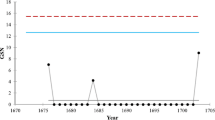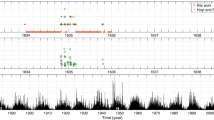Abstract
The Maunder Minimum is the period between 1645 and 1715. Its main characteristic is abnormally low and prolonged solar activity. However, some authors have doubted the low level of solar activity during that period by questioning the accuracy and objectivity of the observers. This work presents a particular case of a sunspot observed during the Maunder Minimum with an unusual shape of its umbra and penumbra: a hexagon. This sunspot was observed by Cassini in November 1676, just at the core of the Maunder Minimum. This historical observation is compared with a twin case that occurred recently in May 2016. The conclusion reached is that Cassini’s record is another example of the good quality of the observations that were made during the Maunder Minimum, showing the meticulousness of the astronomers of that epoch. This sunspot observation made by Cassini does not support the conclusions of Zolotova and Ponyavin (Astrophys. J. 800, 42, 2015) that professional astronomers in the seventeenth century only registered round sunspots. Finally, a discussion is given of the importance of this kind of unusual sunspot record for a better assessment of the true level of solar activity in the Maunder Minimum.



Similar content being viewed by others
References
Arlt, R., Senthamizh Pavai, V., Schmiel, C., Spada, F.: 2016, Sunspot positions, areas, and group tilt angles for 1611 – 1631 from observations by Christoph Scheiner. Astron. Astrophys. 595, A104. DOI .
Bray, R.J., Loughhead, R.E.: 1964, Sunspots, Dover, New York.
Carrasco, V.M.S., Vaquero, J.M.: 2016, Sunspot observations during the Maunder Minimum from the correspondence of John Flamsteed. Solar Phys. 291, 2493. DOI .
Carrasco, V.M.S., Villalba Álvarez, J., Vaquero, J.M.: 2015, Sunspots during the Maunder Minimum from Machina Coelestis by Hevelius. Solar Phys. 290, 2719. DOI .
Casas, R., Vaquero, J.M., Vázquez, M.: 2006, Solar rotation in the 17th century. Solar Phys. 234, 379. DOI .
Cassini, M.: 1730, Suite des Observations Faites à l’observatoire Royal, touchant la tache qui a paru dans le soleil, les mois d’Octobre, de Novembre & Decembre dernier. Memoires de l’Academie Royale des Sciences 10, 581.
Clette, F., Svalgaard, L., Vaquero, J.M., Cliver, E.W.: 2014, Revisiting the sunspot number. A 400-year perspective on the solar cycle. Space Sci. Rev. 186, 35. DOI .
Dobrzycki, J.: 1999, Saturn, Aristotelian astronomy, and Cracow astronomers: an episode from the early years of telescopic astronomy. J. Hist. Astron. 30, 121.
Eddy, J.A.: 1976, The Maunder Minimum. Science 192, 1189. DOI .
Foukal, P.: 1990, Solar Astrophysics, Wiley–Interscience, New York.
Gómez, J.M., Vaquero, J.M.: 2015, The sunspot observations by Rheita in 1642. The Observatory 135, 220.
Hevelius, J.: 1647, Selenographia: Sive Lunae Description, Hünefeld, Danzig.
Hoyt, D.V., Schatten, K.H.: 1998, Group sunspot numbers: a new solar activity reconstruction. Solar Phys. 179, 189. DOI .
Nordlund, A.: 2003, Solar photosphere and convection. In: Dwivedi, B.N. (ed.) Dynamic Sun, Cambridge University Press, Cambridge, 148.
Ribes, J.C., Nesme-Ribes, E.: 1993, The solar sunspot cycle in the Maunder minimum AD1645 to AD1715. Astron. Astrophys. 276, 549.
Solanki, K.: 2003, Sunspots: an overview. Astron. Astrophys. Rev. 11, 153. DOI .
Usoskin, I.G.: 2017, A history of solar activity over millennia. Living Rev. Solar Phys. 10, 1. DOI .
Usoskin, I.G., Arlt, R., Asvestari, E., et al.: 2015, The Maunder minimum (1645 – 1715) was indeed a Grand minimum: a reassessment of multiple datasets. Astron. Astrophys. 581, A95. DOI .
Vaquero, J.M.: 2004, A forgotten naked-eye sunspot recorded by Galileo. Solar Phys. 223, 283. DOI .
Vaquero, J.M., Gallego, M.C.: 2014, Reconstructing past solar activity using meridian solar observations: the case of the Royal Observatory of the Spanish Navy (1833 – 1840). Adv. Space Res. 53, 1162. DOI .
Vaquero, J.M., Vázquez, M.: 2009, The Sun Recorded Through History, Springer, Berlin. DOI .
Vaquero, J.M., Gallego, M.C., Usoskin, I.G., Kovaltsov, G.A.: 2011, Revisited sunspot data: a new scenario for the onset of the Maunder minimum. The Astrophys. J. 731, L24. DOI .
Vaquero, J.M., Kovaltsov, G.A., Usoskin, I.G., Carrasco, V.M.S., Gallego, M.C.: 2015, Level and length of cyclic solar activity during the Maunder minimum as deduced from the active day statistics. Astron. Astrophys. 577, A71. DOI .
Vaquero, J.M., Svalgaard, L., Carrasco, V.M.S., Clette, F., Lefèvre, L., Gallego, M.C., Arlt, R., Aparicio, A.J.P., Richard, J.-G., Howe, R.: 2016, A revised collection of sunspot group numbers. Solar Phys. 291, 3061. DOI .
Zolotova, N.V., Ponyavin, D.I.: 2015, The Maunder minimum is not as grand as it seemed to be. Astrophys. J. 800, 42. DOI .
Acknowledgements
All the historical materials used in this work were consulted at the Historical Archive and Library of the Real Instituto y Observatorio de la Armada, San Fernando (Cádiz), Spain. This research was supported by the Economy and Infrastructure Counselling of the Junta of Extremadura through project IB16127 and grant GR15137 (co-financed by the European Regional Development Fund) and by the Ministerio de Economía y Competitividad of the Spanish Government (AYA2014-57556-P and CGL2017-87917-P).
Author information
Authors and Affiliations
Corresponding author
Ethics declarations
Disclosure of Potential Conflicts of Interest
The authors declare that they have no conflicts of interest.
Rights and permissions
About this article
Cite this article
Carrasco, V.M.S., Vaquero, J.M. & Gallego, M.C. Could a Hexagonal Sunspot Have Been Observed During the Maunder Minimum?. Sol Phys 293, 51 (2018). https://doi.org/10.1007/s11207-018-1270-0
Received:
Accepted:
Published:
DOI: https://doi.org/10.1007/s11207-018-1270-0




